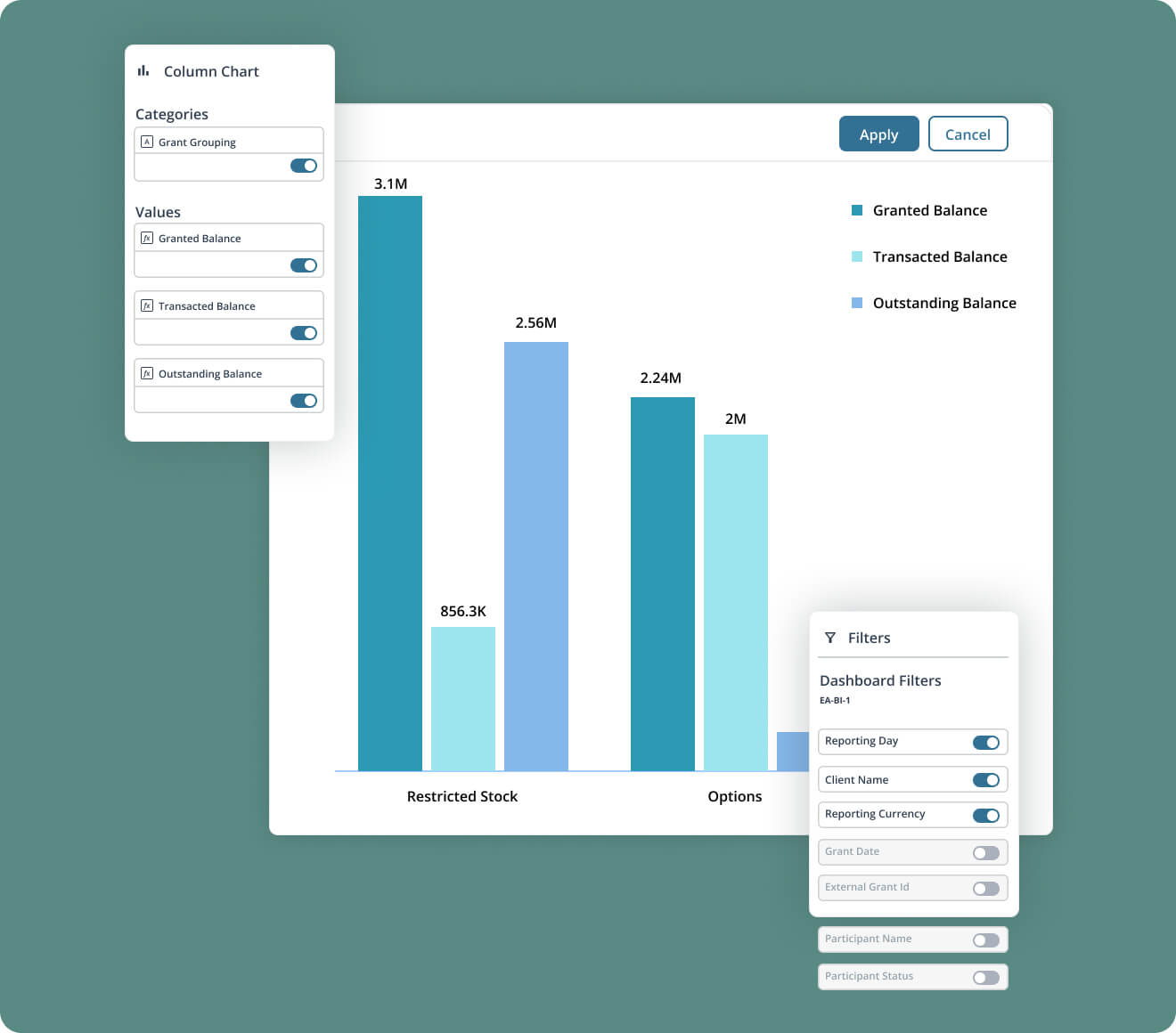Enhanced analytics for all your reporting needs
Our dashboards help you analyze and visualize complex data and gain valuable insights into employee ownership.
Features
GEOGRAPHICAL MAPS
See participants and grants by location
Global and regional maps illustrate how the number of your participants breakdown geographically. At a glance, quickly learn:
- Which countries and states are subject to different taxation laws
- Where translations may be needed
- Where caution is required regarding different or enhanced privacy laws and regulatory topics.

KPI SCORECARDS
Gauges to measure key performance indicators (KPIs)
- Quickly reference and compare values between key areas and understand how they performed in the previous month and over a 24-month period.
- Learn meaningful grant metrics such as the total number of grants (issued versus outstanding) and use values that are aligned with security and reporting currencies.

Charts and Graphs
Visuals that help determine equity trends
- Our charts offer switchable dimension functionality which lets users drill down into granular data sets and understand how different grant types, plans and securities breakdown throughout the company.
- Track metrics that change over time and identify trends in the market. The framework transforms data into an easy-to-understand format which enables data-driven decision-making and improves overall performance.

Reports and Pivot Tables
Detailed reports to examine large datasets
Pivot tables provide a consolidated view of key data points such grants at a tranche level or total grants transacted per different stock plan or security, allowing for easy analysis and comparison. Swap out fields, values and filters to create a table that fits your reporting needs.

Benefits
-
Customizable
Customize your dashboard with a range of features. Use filters to switch dimensions and fields when creating reports to determine what data is shown or hidden, sorted and pivoted.
-
Intuitive insights
Uncover participant insights using data-rich graphics. Present key statistics in an easy to digest way using intuitive visualization tools. Use drag-and-drop features for quick analysis or set a global filter to instantly adjust information at the click of a button.
-
Highly dynamic
With dynamic visuals, you can change a query simply by selecting a section of the graph or chart. For each visual built, you can avail of the drill down capabilities to analyze metrics at a granular detail or combine multiple views to understand the bigger picture.
Product FAQ
-
Can I customize my dashboard in the equity management software?
Yes, our BI Dashboards offer customization options to suit individual or departmental needs. You can choose which KPIs/Dimensions to display, how data is visualized and even set up custom filters. The level of customization will vary depending on an individual’s role and permissions within the organization.
-
How up to date is the information on the dashboard?
The frequency at which data is refreshed depends on the data sets of that dashboard and the specific dashboard setup. Some dashboards update in real-time, while others may do so at scheduled intervals, such as hourly or daily.
-
Can I export data from the dashboard for further analysis?
Yes. Our dashboards allow users to export data into formats such as Excel, PDF or CSV for further analysis or reporting purposes. The availability of this feature and the formats supported may vary depending on the dashboard, chart or report being used.
-
Can additional data or metrics be added to the dashboards?
Additional metrics can be added, but it will depend on where the data is pulled from. Should a client require additional metrics, the reporting team can evaluate the feasibility of integrating new data sources and customizing the dashboard to meet their needs.
-
How does a BI Dashboard ensure data accuracy and consistency?
Data accuracy in BI Dashboards is ensured through data validation rules, data cleansing processes, and the implementation of ETL (Extract, Transform, Load) pipelines that prepare data for analysis. Consistency is maintained by using data model techniques that aggregate data from multiple sources into a single, coherent model and by employing data governance practices.
Ready to learn more about enhanced BI reporting for equity compensation?
Get in touch for more details.
Related insights
-
Is it time to digitize your cap table? Here’s how
September 26, 2024
-
Product news August 2024
August 26, 2024
-
Product news July 2024
July 26, 2024
